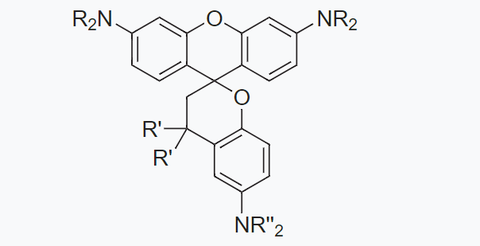The reverse transmembrane pH gradient in cancer cells is a crucial target for disease treatment and can be leveraged for intraoperative histopathological analysis. However, the pathologically relevant pH changes in these cells are subtle and undetectable using traditional Henderson-Hasselbalch-type pH fluorescent probes.
To overcome this limitation, Professor Yang Youjun’s team at East China University of Science and Technology developed a novel class of highly sensitive Hill-type pH fluorescent probes (PHX series) [1][1][1].
J&K Scientific provides the PHX series probes developed by Professor Yang Youjun, which are designed for high-sensitivity pH detection across a variety of biological environments (Figure 3).
Professor Yang Youjun:
Professor Yang Youjun, currently based at the School of Pharmacy at East China University of Science and Technology, leads a research group focused on designing and synthesizing functional fluorescent dyes. Their work spans pharmaceutical-related research, including medicinal chemistry, pharmacology, pharmaceutics, and chemical biology. The research is supported by funding from the National Science Foundation, Municipal Science and Technology Commission, and Municipal Education Commission. The team’s work has been published in prestigious journals such as JACS (4 articles), Angew, PNAS, Anal. Chem. (5 articles), Org. Lett., Chem. Comm., and J. Org. Chem.

Figure 3 General structure of PHX series probes
| Product name | pKa | Item number |
|---|---|---|
| PHX3.5, 97% | 3.5 | 9189176 |
| PHX4.7, 97% | 4.7 | 9189175 |
| PHX5.0, 97% | 5.0 | 9189174 |
| PHX5.3, 97% | 5.3 | 9189173 |
| PHX6.0, 97% | 6.0 | 9189172 |
| PHX6.4, 97% | 6.4 | 9189171 |
| PHX6.8, 97% | 6.8 | 9189170 |
Usage Instructions:
- When staining biological samples, the fluorescence intensity changes can be monitored using standard fluorescence microscopy imaging equipment.
- The PHX dye has a maximum excitation wavelength of 553 nm and a maximum emission wavelength of 575 nm. The standard red channel of wide-field fluorescence microscopes can be used for imaging.
- For confocal imaging or flow cytometric analysis, a laser line within the 520-560 nm range is recommended for excitation.
References
- Xiao Luo, Haotian Yang, Haolu Wang, Zhiwei Ye, Zhongneng Zhou, Luyan Gu, Jinquan Chen , Yi Xiao, Xiaowen Liang*, Xuhong Qian, and Youjun Yang*. Highly Sensitive Hill-Type Small-Molecule pH Probe That Recognizes the Reversed pH Gradient of Cancer Cells. Anal. Chem., 2018, 90, 5803–5809.
